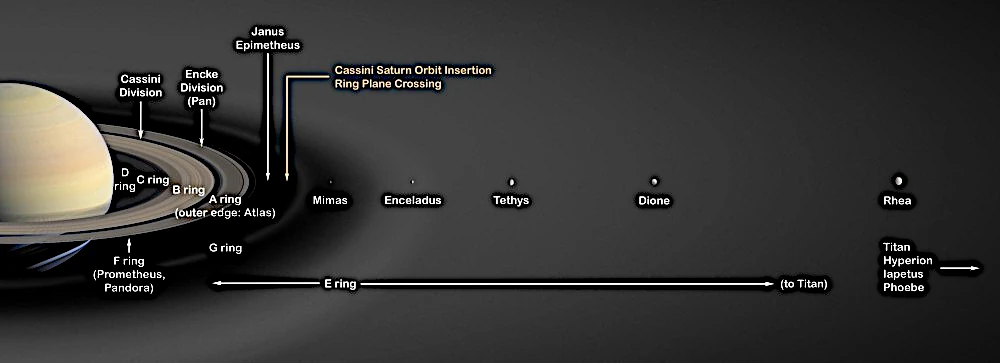
With 146 confirmed moons as of 2025 (24 of which are still awaiting official names), Saturn holds the solar system record for the diversity of its natural satellites. These celestial bodies, ranging in size from a few hundred meters to over 5,000 km for Titan, offer a unique laboratory for studying geological processes and exobiological potential beyond Earth.
Data collected by the Cassini-Huygens mission (1997-2017) revealed surprising landscapes:
With a diameter of 5,151 km (larger than Mercury), Titan is the only moon in the solar system with a dense atmosphere (1.5 times Earth's pressure), composed of 95% nitrogen. Radar observations have confirmed the presence of seas of liquid methane and ethane, as noted by Carolyn Porco (1953-): "Titan is the most Earth-like world we have found, but with exotic chemistry where methane plays the role of water." Climate models suggest a complex seasonal cycle where methane rains carve river networks similar to those on Earth, but at average temperatures of -179°C.
Flybys of Enceladus (504 km in diameter) revealed plumes rich in nanocrystalline silica, molecular hydrogen, and organic compounds. According to a study published in Science (2017) by Hunter Waite (1959-), these elements suggest active hydrothermal vents at the bottom of its subsurface ocean, similar to those that host life on Earth near ocean ridges.
The Cassini probe measured a heat flow of 15.8 ± 3.1 GW at the south pole, 2.6 times the energy produced by all of Earth's hydrothermal vents. This energy, combined with the presence of ammonia (which acts as antifreeze), maintains a global ocean 26 to 31 km thick beneath an ice crust 20 to 25 km thick.
| Moon | Diameter (km) | Distance from Saturn (km) | Major characteristic | Habitability index (0-1) | Discovery (year) |
|---|---|---|---|---|---|
| Titan | 5,151 | 1,221,870 | Dense atmosphere (95% N2) + liquid methane/ethane lakes + seasonal cycles | 0.64 | 1655 |
| Enceladus | 504 | 237,948 | Active geysers (200 kg/s vaporization) + global ocean (26-31 km deep) + confirmed hydrothermal activity | 0.78 | 1789 |
| Rhea | 1,528 | 527,108 | Ancient, cratered surface (temperature: -174°C) + possible tenuous ring system | 0.12 | 1672 |
| Dione | 1,123 | 377,415 | Tectonic fractures (chasmata) + possible subsurface ocean (detected by Cassini in 2016) | 0.35 | 1684 |
| Iapetus | 1,470 | 3,560,820 | Hemispheric dichotomy (albedo 0.03-0.6) + equatorial ridge (20 km high) | 0.08 | 1671 |
| Tethys | 1,062 | 294,619 | Large Odysseus crater (400 km) + Ithaca Chasma canyon (100 km wide) | 0.21 | 1684 |
| Mimas | 396 | 185,539 | Herschel crater (130 km, 1/3 of diameter) + orbital resonance with Enceladus | 0.05 | 1789 |
| Hyperion | 270 | 1,481,100 | Irregular shape (sponge-like) + chaotic rotation + CO2 ice-rich composition | 0.03 | 1848 |
| Phoebe | 213 | 12,944,300 | Probable origin in the Kuiper Belt + retrograde orbit + dark surface (albedo 0.06) | 0.01 | 1899 |
| Enceladus (south pole) | - | - | Local temperature: -93°C (vs -198°C elsewhere) + 101 identified geysers | 0.85 (specific area) | - |
Three missions are under development to study these moons:
Analysis of returned samples could answer the question posed by Carl Sagan (1934-1996): "Are we alone in the universe?" The subsurface oceans of these moons are indeed the most promising environments for finding extraterrestrial microbial life in our solar system.